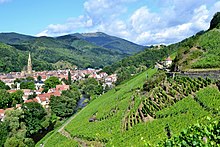 | ||
| Thann | ||
| region | Grand Est | |
|---|---|---|
| Residents | 7.721 (2018) | |
| height | 343 m | |
| no tourist info on Wikidata: | ||
| location | ||
| ||
Thann (Alsatian Then) is a french City in the department Haut-Rhin, in the Alsace in the Vosges. This is where they end Alsatian wine routeRoute des vins d'Alsace and the Vogesenkammstraße Route des Crêtes.

background

It is the capital of the Arrondissement of Thann and the administrative seat of the Canton of Thann.
It is located at the exit of the Thur valley, which leaves the Vosges here.
The foundation of the place goes back to the promise to build a church here, around which the place arose. This promise was made on the occasion of a miracle in 1161. When the servant of the late Bishop of Gubbio stopped here on his journey to Italy, he stuck his walking stick with the finger relic into the ground. Suddenly three lights appeared in the forest and the staff could not be pulled out until the building of a church was praised. This was then also built on the site of the three lights. The actual settlement is first mentioned in a document in 1290 and received city rights in 1360. Until the Thirty Years War, the city belonged to the Upper Alsatian part of Upper Austria. In 1659, King Louis XIV donated the city to Jules Mazarin, whom the Sun King wanted to reward for his services.
In the 19th century and into the 1960s, Thann was strongly influenced by the textile industry. In addition to the various textile factories, there was also a chemical factory for the manufacture of paints. It is considered the oldest chemical factory in Europe and still exists today. As early as 1839, a passenger rail link between Mulhouse and Thann was opened. As a result of the Franco-German War, the city fell to the German Empire together with Alsace in 1870, which caused many residents to leave the city. During the First World War, Thann was recaptured by France as early as 1914, but was severely damaged in the process. Until the end of the war, Thann was the capital of "liberated" Alsace in the terminology of the Nazi rulers for four years.
The Rangen vineyards are located in the municipality. It is one of the 50 locations in Alsace with the predicate Grand Cru.
In addition to viticulture, the city now lives from tourism and service companies.
getting there

By train
From Mulhouse you can take the tram train to Thann every half hour on weekdays. TER condense the clock. With the TER you can be in Thann in 18 minutes. The tram train takes 35 minutes. However, it stops in the city center and at the Cité du Train and is therefore more practical to get to the city center. At the weekend there is a tram train every hour.
In the street
- Route des Vins d'Alsace - Alsatian wine route
- Route des Crêtes - Vosges ridge road
By bicycle
- Voie Verte de la vallée de la Thur (Green Path in the Thur Valley)
mobility

Tourist Attractions



- Munster Saint Thiébaut. The St. Theobaldsmünster was built between 1332 and 1516. With its 76 meter high tower, it is the symbol of the city. The richly decorated figure portal on the west side is one of the most important late Gothic architectural sculptures. It was built between 1380 and 1400 and tells the life of Christ and Mary in around 15 scenes with 500 figures. There is also a small figure portal on the north side from 1450. In the three-aisled interior you can clearly see the different construction phases. In the 17th century a side chapel was added in which the Winemaker Madonna is located. This painted wooden figure was created around 1510.
- historical Museum, 24 rue Saint Thiébaut, 68800 Thann. Tel.: 33 3 89 37 14 54. The Historical Museum is located in the former Kornhaus (Halle aux blés) from 1519, directly on the Thur north of the minster.Open: Tuesday - Sunday: 2pm - 6pm.Price: adults € 2.50, children (6-16 years) 1 €.
- Tour des Sorcières. The witch tower is a relic of the former city fortifications. In the cellar vault there is an exhibition about wine growing in the region.

Outside:
- Castel Sant'Angelo. The Castel Sant'Angelo was located on a wooded hill in the city. This was done in several stages between the 12th and 16th centuries. Century built. In 1673 it was destroyed on the orders of Louis XIV. A mighty ring-shaped stone of the keep was tipped over the slope in such a way that its opening now looks down to the city, which resulted in the nickname "Œil de la Sorière" (witch's eye). The ruins are a 30-minute walk from town.
activities
- Crémation des trois sapins. On June 30th every year the folk festival "Burning of the Three Firs" is celebrated. At this festival one commemorates the miracle that is said to have led to the foundation of the place.
shop
kitchen
nightlife
accommodation
security
health
Practical advice
trips
- Husseren-Wesserlin. 12 km to the northwest, with the Royal Textile Manufactory from 1783, the Textile Museum and a beautiful park.
- Parc Régional des Ballons des Vosges
- Ballon d'Alsace. 1247 m, with a magnificent panoramic view.
- Grand Ventron. 1202 m.
- Col des Bussang. 731 m high pass.
- On the D14 to Col de Hunsrück (748 m), continue to
Masmunster (Masevaux)
literature
Web links
- https://ville-thann.fr/ - Official website of Thann

